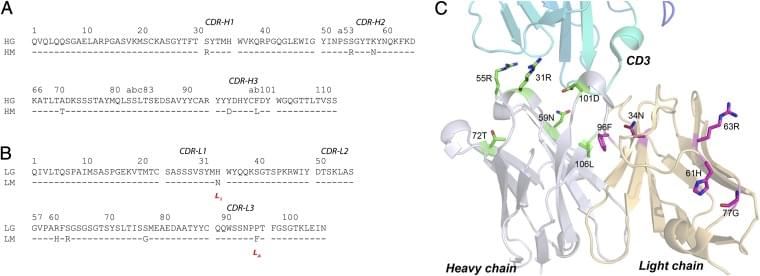Creative Biolabs is glad to introduce a unique antibody stability improvement service. With the consistent growth of therapeutic antibodies in global market, many efforts have been made to improve the engineering technologies, safety and efficacy of therapeutic antibodies, among which stability is one of the most important functional requirements for the use of antibodies in therapeutic and diagnostic applications.
 Fig. 1 Somatic
Mutations to Improve Antibody Stability. (Wang et al. 2013)
Fig. 1 Somatic
Mutations to Improve Antibody Stability. (Wang et al. 2013)
Creative Biolabs offers high-quality services for antibody/therapeutic protein engineering at competitive prices as compared with traditional methods.
Antibody/therapeutic protein engineering aims at developing proteins of clinical potentials with enhanced efficacy and safety, reduced immunogenicity and improved delivery. Antibody-based drugs are the largest and fastest growing class of protein therapeutics, such as clinically successful antibody-drug conjugates and bispecific antibodies. Besides that, engineered protein scaffolds are also in early clinical development, offering some potential advantages over conventional antibodies. We have established a platform for antibody/therapeutic protein engineering with high-quality services like antibody humanization, affinity maturation, single domain antibody generation, epitope mapping, scFv or Fab antibody libraries construction, antibody sequencing and so on.

Figure 1. Overview of currently marketed protein therapeutics from a protein engineering perspective. (Paul J. Carter, 2011)
In developing protein therapeutics, concerns on their pharmaco -kinetics and -dynamics must be carefully addressed. Though proteins and peptides are becoming more popular as an important therapeutic tool for the treatment of various diseases, they have significant limitations as well. For example, the administration of protein-based pharmaceuticals can be challenging in the case of eye diseases, as the peculiar structure of this organ and the presence of numerous barriers shield the inner structure of the eye. This issue has been partially solved by nanoencapsulation of peptides and proteins, which offers a few advantages for their ocular delivery: i.e., protection the drug from metabolic activity, controlled and sustained release, and increased drug bioavailability after topical or intravitreal administration. Another similar example is seen in the delivery of protein drugs to the brain. Parenteral administration of proteins cannot enter the brain due to both their poor bioavailability and the existence of the blood-brain barrier (BBB). Other barriers also exist even if proteins are administered through non-parenteral routes. Chemical modification of proteins and use of particle-based carriers have been used to increase such delivery in relevant CNS disease models, and a few have attained proof of concept clinically.
Therefore, to better develop these therapeutic protein molecules, we must have a good understanding of the determinants that control their properties. One approach is to model the pharmaco -kinetics and -dynamics during the preclinical stage with integrated exposure and efficacy/toxicity data. These preclinical models are very useful in optimizing the experimental designs for further preclinical experiments. What’s more, these models also provide the structure for future clinic evaluation, when appropriately simplified and statistically adjusted. Lastly, these models also enhance the preclinical-to-clinical translation of protein therapeutics.
Advancement of the synthesis of protein therapeutics has been rather rapid. As compared with conventional methods that produce proteins only, new ones can take advantage of the ability for proteins to interact with nanoparticles (NPs), an synthesize protein-NP conjugates with altered clearance, biodistribution, and toxicity properties.
We can assist you in your antibody/protein engineering projects, especially when certain pharmaco-properties are desired. With our rich experiences, we are confident to provide you with the first-class services and meet your research needs.
Reference
All listed services and products are For Research Use Only. Do Not use in any diagnostic or therapeutic applications.